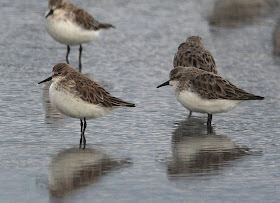
At the roost, birds tend to divide into groups according to size. Whether this is determined by the depth of water they are comfortable to stand in or some other factor is difficult to say. Anyway, at the front are the sand plovers, Tereks and smaller calidrids; in the mid-distance are the Grey Plovers, knots and Tringas, and at the back, the godwits and Whimbrels.

Of course, these are not rigid distinctions, and you do get occasional non-conformists, like the Great Knot in this picture.

Or the Black-tailed Godwit in this one!

The adult male Bar-tailed Godwits are looking stunning now. They are smaller than females, and have shorter, narrower bills.

The less bright birds behind could be females or immature birds.On the other hand, there's been some research which indicates that the extent of breeding plumage acquired during migration could also indicate things like fitness to breed or even tapeworm infestation!

A couple of Great Knots joining a band of Bar-tailed Godwits, Grey Plover, Common Redshanks and Whimbrel.

Breeding plumaged Bar-tails have chestnut all the way to the undertail coverts. Black-tailed, on the other hand, have the chestnut mainly restricted to the breast and flanks, where it gives way to fantastic 'tiger-stripes' on the belly, making this one of the most attractive waders of all in my view!

Note the subtly different-shaped bill and head pattern of Black-tailed compared to Bar-tailed. I just noticed that the Great Knot to the left appears to have a green ring on the tibia. However, it doesn't look like a conventional leg flag. Can anyone shed any light on this?

Great Knots (and a Red Knot) huddle together in typical knot fashion! Their cryptic plumage does a great job of breaking up their outlines. I imagine they'd be almost impossible to find when sitting on a nest in the Arctic tundra.

There's great variation in the extent of rufous on the scapulars, and there's some evidence that this increases in extent via an extra partial moult after the birds reach the breeding grounds.


A couple more for good measure. I love the heart-shaped spots on the flanks!

One of the brighter Red Knot. This one seems to be of the 'piersmai' race, judging by the richness of the red on the underparts and new scapulars.

I was surprised that most Grey Plovers were not well-advanced in their body moult. Perhaps I had already missed the main passage of breeders.

Sand Plovers are generally easy to identify at this time of year, since the Greaters have almost all moulted into breeding plumage, whereas the Lessers mostly haven't.

A line of Lesser Sand Plovers all seem to be gazing rather enviously at this splendid Greater Sand!

Eighteen of the 41 Nordmann's Greenshanks on show (which works out as 5% of the estimated world population!).
Lots of pics, for which no apology!






Some handy comparisons with Common Greenshanks.

And with Terek Sandpiper, to which it is often compared, shape-wise.

Foursquare! Seven Tringas, four species: Marsh Sandpiper, Common Redhsank, Common Greenshank and Nordmann's Greenshank.

First year birds (right) are obviously plainer than adults (left), and have a more clearly bicoloured bill.




A few more portraits.

And one more of that underwing!
Or click here for the full version.

Moving on...! I did manage to spot a Singapore-flagged Curlew Sandpiper from Sungai Buloh. As far as I know, this it the first sighting of a Singapore-flagged bird in Malaysia. I suppose most of them fly straight over.

There were 2600 Red-necked Stints to be sifted through. No cutlery was in evidence sadly, but there were a number of Little Stints, some easier than others.

Here's one of the easier ones.

Bright chestnut fringes to the coverts are a giveaway feature of Little (right). At best, Red-necked may show a few chestnut-edged tertials and inner greater coverts.Mostly, Red-necked shows grey-brown fringed coverts in breeding plumage.


Another individual with some signs of breeding plumage, again, with some tell-tale chestnut on the lesser and median coverts.


This much less obvious individual (left) can be identified by the finer bill (more obvious on this bird than on some other Littles), longer legs (very evident in the field, less so in this pictures), and body shape - round body with small, high-foreheaded head up on top of the body rather than in front of it. Note also the thick-necked appearance of the Red-necked - absent on Little.

A fourth bird (right) - rather tatty-looking. Despite this, long legs and bill and body shape mentioned above give it a distinctive appearance.


And a fifth, typically rather browner than Red-necked in non-breeding plumage, with a distinctive pointy-ended supercilium. This bird has a rather thicker bill than the two above, but it still tapers rather more than Red-necked. The legs are markedly longer (they appear yellowish, but I think this is mud). Note also the darker central crown when seen head-on.
Here's the same bird (and the second in this series also makes an appearance from 0 up to about 19 secs and again at 38 - 41 secs). To see the full, untruncated version of this video, go to this link.
By dusk I had enjoyed a fantastic show. The following morning my plans to have another session in the hide were spoilt by torrential rain, so I headed back to Penang well satisfied with what I'd seen, knowing that I would be back again in a couple of weeks time.
Wow! Amazing about sums it up. Stunning images.
ReplyDeleteStunning photos of shorebirds especially the Nordmann's Greenshank.
ReplyDelete